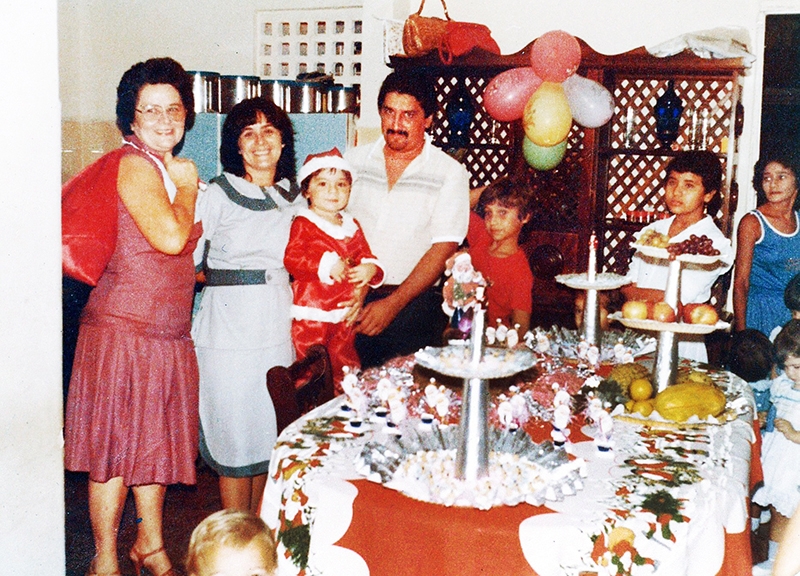
As Christmas gets closer, Christmas trees, lights and Santa Claus take over homes, streets and cities across the United States. It’s tradition.
But Christmas traditions vary around the world. And for the many priests in the Diocese of Nashville who were born in other countries, the Christmas celebrations of their youth had a different feel than what they’ve found in the United States.
Christmas Eve party
Father Gervan Menezes, University Catholic chaplain, grew up in Fortaleza, Brazil, which is in the northeastern part of the heavily Catholic country.
“Brazil being the biggest Catholic country in the world, Christmas is huge there,” Father Menezes said. “Families go to Mass and have celebrations at the house, and they bring in baby Jesus and sing.
“Even those far away from the church would still come and pray together,” he added.
The massive celebrations always happened on Christmas Eve, he said.
“My birthday is the 24th, and I would always get one gift per thing,” he said. “I felt like I always got cheated a little,” he said with a chuckle.
Father Menezes had exposure to the United States’ traditions even before he permanently immigrated in 2010 having seen traditional Christmas movies and spending a year as an exchange student in 1996 for his sophomore year of high school. And many of the same portrayals of the season were seen in Brazil such as fireplaces, stockings and Santa’s big red suit, even though it “didn’t make much sense.”
“My part of the country is a really hot one … but I remember decorations like fake fireplaces …and Santa in the big red suit,” he recalled. “So, in the sense, it is the global understanding of Christmas as it’s portrayed in American movies.
“But it is summertime in Brazil in December.”
Decorating churches
When Father Tien Tran, associate pastor of St. Matthew Church in Franklin, was growing up in Vietnam, churches were the focus of Christmas celebrations rather than the homes of individual families.
“Christmas is not a national holiday,” Father Tran said. “If you choose to be off on December 25th, you don’t get paid for that day. But the people still take off to celebrate, Catholics and non-Catholics alike.”
And the country’s minority Catholic population doesn’t hesitate to celebrate the season in a big way.
“The Catholics are a little population, but a really powerful one,” Father Tran said. “The bishops and priests are really faithful to the Catholic population.”
The decorations at the churches are “extravagant,” he said.
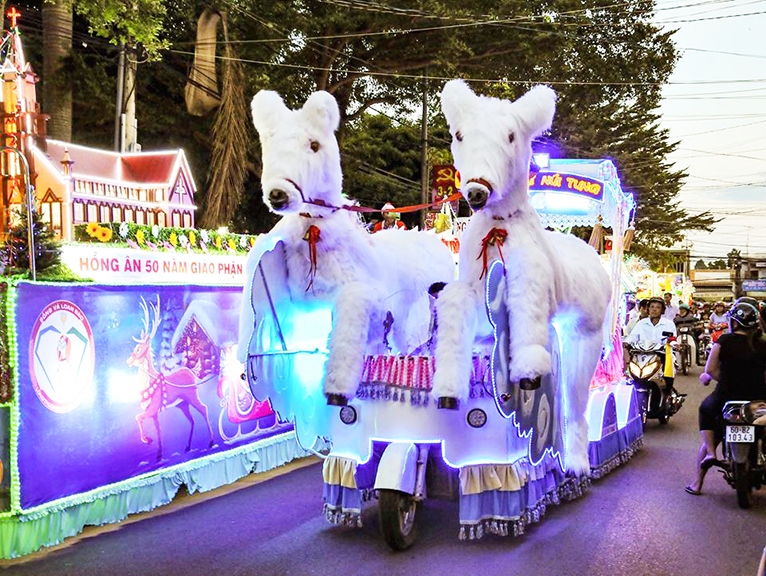
“The Church in our communities, a few weeks before Christmas, they set up all the lighting decorations and trees leading into the church. It’s really, really exciting when that’s all up,” Father Tran said. “All the people … come and visit the churches because it’s such beautiful decorations. And they build a huge nativity scene outside, too.
“At the cathedral, they have a really huge Christmas parade before Christmas Eve, too,” he said. “Then, several of the churches, they make nativities in the church and all the kids dress up like shepherds and angels, and they stand in the manger for the whole of midnight Mass.”
Those extravagant outdoor decorations were usually left to the churches rather than families’ homes, so when his family first came to America in 1997, Father Tran said, they went all out at home for the first time.
“We did everything. We bought every light that you put on the roof and the lawn, and it was beautiful,” he said. “Then, later on, holy cow, the electric bill came.”
Snow and Santa Claus were new experiences, too, for Father Tran and his family.
“Our first Christmas in America, my whole family was in a Vietnamese Choir … and I was one of the cantors for Christmas Mass,” Father Tran recalled. “But there was a really bad snowstorm on that day, and we couldn’t get out. When we did get out, our car went off the road. It took all night to get it out. It was cold, but it was fun.
“Santa was a new concept, too, especially for the Christmas gift giving,” he said. “We didn’t have much with that in Vietnam because of the economy. … That’s a beautiful part of the celebration here.
“Then, of course, to be able to have Christmas together … and the kids to be able to have a week off from school as well, is wonderful.”
Mary is key
Father Seondo Bang, pastor of the Church of the Korean Martyrs for the Korean Catholic Community in Nashville, said that while many traditions are the same in the Daegu Archdiocese in South Korea where he is from, one of the biggest differences is the importance of Holy Mother Mary and obligatory annual confession.
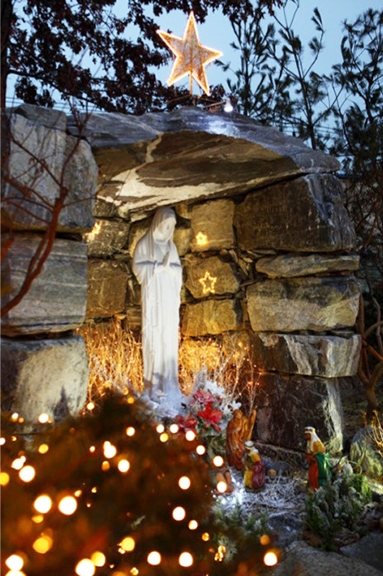
“Decorations (such as lights) around the statue of Mary is one of the most important things,” Father Bang said. “Koreans love Holy Mother Mary. She, the Immaculate Conception is the patron saint of the Catholic Church of Korea since 1831.”
Additionally, Father Bang said Korean Catholics get a ticket for annual confession from their parish church and should give the ticket to any priest and take confession during Advent. Then, the ticket should be delivered to their parish church.
“This is a unique Korean Catholic tradition for the glory of God,” he said.
Like in America, Korean Catholics also recognize the nine days of prayer, or the Christmas Novena, during the final days of Advent, culminating in a celebration which includes gifts from Santa Claus, food and family.
“Christmas Day, it’s like a festival,” he said.
Las Posadas
Mexico is another primarily Catholic-Christian country, making up nearly 80 percent of the population, and like Brazil, most of the celebration happens on Christmas Eve.
The first tradition is the celebration of the Las Posadas, which commemorates the journey of Joseph and Mary from Nazareth to Bethlehem as they sought a safe place to stay for the birth of Jesus. From Dec. 16 through Christmas Eve, children, dressed as angels, will lead a procession, stopping at selected homes to ask for a place to stay.
“The people bring statues of the Holy Family, and we’re singing and asking for lodging for the family,” explained Father Alejandro Godinez, associate pastor of the Sagrado Corazon de Jesus in Nashville.
Before midnight Mass on Christmas Eve, the Mexican community will also pray the rosary and the families will choose a “sponsor” for baby Jesus.
“At the end of the rosary, the sponsor takes the baby Jesus and cleans it with perfume, dresses it and sits it in a chair where the baby Jesus stays until Feb. 2,” Father Godinez said. “We do the same on Feb. 2, but this time we undress the baby, put him in pajamas and put him to sleep for the rest of the year.
“And everybody comes and kisses the baby and grabs a candy,” he added.
Food is a big part of the Mexican Christmas celebration, too, added Father David Ramirez, pastor of Sagrado Corazon.
For example, during the feast of the Epiphany, little plastic babies are placed throughout a King’s Cake, and if a baby is found in someone’s slice of cake, they then have to bring tamales to the celebration on the Feast of the Presentation of the Lord on Feb. 2, to share with everyone.
“You gain a lot of weight during this time,” Father Ramirez said. “That is a lot of food from everywhere.”
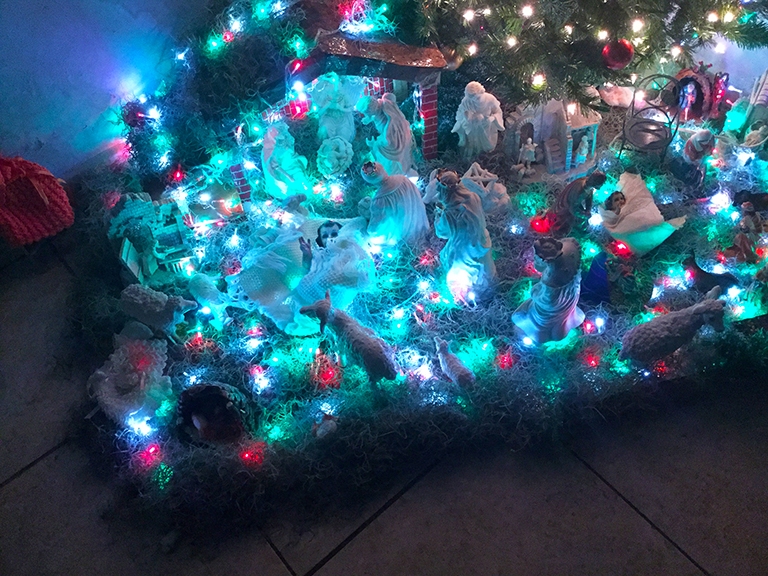
A family affair
For Father Delly Mutajuka, administrator of Sacred Heart Church in Loretto and St. Joseph Church in St. Joseph, Christmas in Tanzania meant a family reunion.
“Christmas is always a good celebration there, especially as you reunite with your family because you don’t see each other throughout the year because you work in different cities,” Father Mutajuka explained. “Christmas is a time where families come together and celebrate.”
A typical celebration includes attending midnight Mass, so they can sleep in on Christmas Day before preparing a traditional Christmas meal complete with rice, beef, goat meat and greens.
“Usually, they serve it together on one big plate and we sit around the circle to dip from the same plate,” Father Mutajuka said. In America, “the food is a little bit different … and seems to depend on the family.”
Then, later in the day, instead of Santa Claus coming to each home, the families go to the local park where Santa is waiting with a gift for each person.
“They have different games for the kids, and it’s like a family-oriented big space where they have all this special entertainment,” he said.
Then, because Tanzania was colonized by the British, Tanzanian families follow the English tradition of exchanging and opening presents on Boxing Day, Dec. 26.
So, when Father Mutajuka came to America in July 2007, his first Christmas was met with a few surprises including snow, lights among the decorations, and the different versions of traditional Christmas Carols. But, he said, he enjoys seeing all of it.
“There aren’t many decorations (in Tanzania) because a lot of people can’t afford the electricity bills. It’s also not safe in terms of somebody may come and take it out because they’re not used to that,” he said. “I like how Christmas here with all the Christmas Carols … and decorations, especially as you go through the streets at night, they enlighten us and brighten our hearts as we prepare and wait for the actual Christmas Day.”
A 25-Day Celebration
In India, particularly in the southern state of Kerala, where it is believed St. Thomas baptized some of the first Christians, the celebration begins Dec. 1, according to Fransalian Father Regi Augustine, pastor of St. John the Evangelist Church in Lewisburg.
For all 25 days, every Christian attends Mass, and the children who attend all 25 days receive special gifts after midnight Mass on Christmas Eve, Father Augustine said. Additionally, churches will split up into teams and travel to every parishioner’s home over the course of 25 days to sing Christmas Carols.
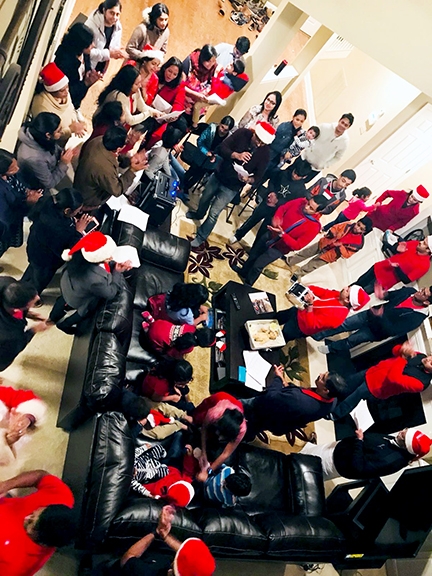
“We go to each house with a statue of infant Jesus, and we receive the families,” he explained. “And the caroling team is accompanied by Santa Claus.”
Catholics in India also abstain from meat, fish and sometimes even eggs during the full 25 days, he said.
“We tell parishioners that the money saved by not eating meat and fish, they should use for charity,” he said. “That is the intention behind it.”
The typical decorations are slightly different, too, Father Augustine said. For example, instead of wreaths on the door, Catholic homes in India typically have the Christmas star.
“Every home you can find a star in front of the house,” he said. “Every shop, every supermarket you can see different varieties of stars in all kinds of colors and sizes.”
Also, instead of contests for Christmas tree decorating, they have a crib building contest.
“The crib is one of the most significant depictions of the birth of Jesus. Most people around India use ceramic figurines and small piles of hay to depict the birth of Christ in the manger,” Father Augustine said. “Crib competitions are conducted by the parishes and most families take part in it. The best cribs are given awards.
“In the parishes, beautiful cribs are also put up by the youth,” he added.
The food is traditional among families, too, he said.
“Varieties of Christmas cakes are available during the Christmas season. Plum cake is the most attractive and tasty among them,” Father Augustine said. “And we distribute them to non-Christian families during Christmas.
“Then, in Kerala, the Christmas special dish is Toddy Appam, (which is similar to a pancake), along with mutton or chicken stew; the best breakfast delicacy everyone must taste,” he said.
The Spirit Remains
Whether its celebrating on Christmas Eve, indulging in a different kind of meal, or decorating with the Christmas Star instead of a wreath, as Catholics, no matter what country you’re from, it all comes back to the true reason for the season: celebrating the birth of Christ.
“If we understand what Christmas is about, that it’s about the birth of Christ, I think that’s what cannot change,” said Father Menezes. “It’s about preparing for Jesus’s second coming … so we must be aware, be prepared, be vigilant.
“Post-Thanksgiving, we’re cleaning the house and figuring out where to put the Christmas tree, and that’s what we have to do in our hearts,” he said. “Two thousand years ago, when Jesus came, there was no place for him to be born. Are we going to be able to give him a place in our hearts?
“That’s the mic drop of Christmas,” he continued. “That’s why we have to enter ourselves and provide a place for Christ to be born again.”
Father Mutajuka said the true purpose comes out in “the beauty of the Mass itself on Christmas.”
“The beauty of the liturgy and how reverent it is, it’s the same no matter the place,” he said. “Even though you might not have the same language, the structure is the same and you can still follow along.”
Recognizing the importance and reason for the season is even more important this year after COVID has caused a separation among families, Father Augustine said.
“Christ has come for the salvation for all, and the birth of Christ is the starting point for the culmination at the cross for salvation history,” Father Augustine said. “Christmas is a time to renew one’s strength in relationships. What happened the last two years with COVID, I think we have slowly lost that feeling that we are one community.
“This is a time to recommit ourselves to that relationship and bring back and re-establish those things and, as Christians, we need to be aware that Christ is the center of our lives.”









